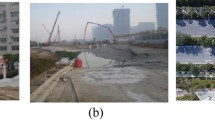Abstract
The underground excavation became the backbone of developing as well as developed country due to unavailability of surface area and increase demand of space for transportation, water channeling, waste disposal and storage. Except for transportation, the crystalline rocks (high strength, low porosity and less permeability) are considered most suitable and safe space for the storage of radioactive waste as well as petroleum. The role of spacing between twin tunnel and tunnel’s diameter in its stability was carried out using finite element method. Not much research has been done on twin tunnel spacing in hard rock. In the present study, a total of ninety simulations were performed to investigate critical spacing of the twin tunnel in granitic rock mass. Twin tunnel diameter is varied from the 2 m to 10 m and their spacing varied from 0.2 to 2 times of diameter. It was concluded that minimum spacing should be 0.8 times of the tunnel diameter. It was also found that small diameter tunnel effects only near field but large diameter tunnel effect near field as well as far field. The vertical hole, approximately 3m diameter, containing radioactive waste canister should be drilled at the interval of more than 2.4m.
Similar content being viewed by others
References
Barton, N., Lien, R. and Lunde, J. (1974) Engineering Classification of Rock Masses for the Design of Tunnel Support. Rock Mechanics, v.6, pp.189–236.
Bieniawski, Z.T. (1989) Engineering Rock Mass Classifications, Jonn Wiley.
Bieniawski, Z.T. (1973) Engineering Classification of Jointed Rock Masses. The Civil Engineer in South Africa, v.15, pp.335–344.
Brown, E.T. and Hoek, E. (1997) Practical Estimates of Rock Mass Strength. Internat. Jour. Rock Mech. Min. Sci., v.34(8), pp.1165–1186.
Chakeri, H., Hasanpour, R., Hindistan, M.A. and Unver, B. (2011) Analysis of interaction between tunnels in soft ground by 3D numerical modeling. Bull. Engg. Geol. Environ., v.70, pp.439–448.
Hoek, E., Carranza-Torres, C. and Corkum, B. (2002) Hoek-Brown failure criterion–2002 edition, Proc. NARMS-TAC Conference, Toronto, pp.267–273.
ISRM (1981}) Rock characterization testing and monitoring: ISRM suggested methods, Pergamon Press
Karakus, M., Adymd, O. and Basarur, H. (2007) Finite element analysis for the twin metro tunnel constructed in Ankara Clay, Turkey. Bull. Engg. Geol. Environ., v.66, pp.71–79.
Lee, J. (2009) An application of three-dimensional analysis around a tunnel portal. Tunnelling and Underground Space Technology, v.24, pp.731–738.
Shen, B. and Barton, N. (1997) The disturbed zone around tunnels in jointed rock masses. Internat. Jour. Rock Mech. Min. Sci., v.34(1), pp.117–125.
Singh, P.K., Kainthola, A. and Singh, T.N. (2015) A distinct element modeling approach towards rockfall analysis. Jour. Engg. Geol., v.XL (1), pp.119–129.
Singh, T.N., Ahmad, M., Kainthola, A., Singh, R. and Kumar, S. (2013) A Stability Assessment of a Hill Slope–An Analytical and Numerical Approach. Internat. Jour. Earth Sci. Engg., v.6(1), pp.50–60.
Terzaghi, K. (1946) Rock Defects and Load on Tunnel Supports. Introduction to Rock Tunnelling with Steel Supports, a book by Proctor, R.V. and White, T.L., Commercial, Sheering & Stamping Co., Yougstown, Ohio, U.S.A.
Verma, A.K., Bajpai, R.K., Singh, T.N., Narayan, P.K., Dutt, A., (2011) 3D instability analysis of an underground geological repository—an Indian case study. Arabian Jour. Geosci., v.4(7-8), pp.1173–1188.
Zeng D., Noriko Katsube, Jinmiao Zhang, Wole Soboyejo (2002) Hybrid crack-tip element and its applications. Finite Elements in Analysis and Design, v.38, pp.319–335.
Author information
Authors and Affiliations
Corresponding author
Rights and permissions
About this article
Cite this article
Singh, R., Singh, T.N. & Bajpai, R.K. The Investigation of Twin Tunnel Stability: Effect of Spacing and Diameter. J Geol Soc India 91, 563–568 (2018). https://doi.org/10.1007/s12594-018-0905-y
Received:
Accepted:
Published:
Issue Date:
DOI: https://doi.org/10.1007/s12594-018-0905-y




